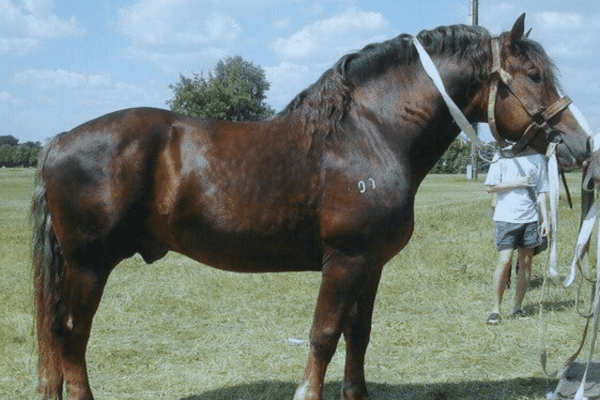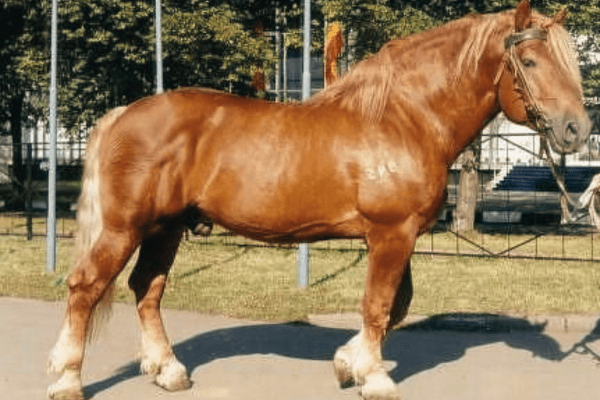The Soviet Heavy Draft, a distinguished Russian breed of heavy draft horse, is renowned for its considerable size and robust stature. Originating from the Belgian Brabant, a breed known for its formidable strength, the Soviet Heavy Draft has carved its own niche in equine circles.
Currently, this breed enjoys sustained demand, largely attributed to its impressive physicality and fluid gaits. Beyond their traditional roles, these horses are also valued for their contributions to dairy and meat production. A notable characteristic of the Soviet Heavy Draft is its rapid maturation, which allows for their versatile utility in various domains within a comparatively short timeframe.
History:
The creation of the Soviet Heavy Draft horse is an intriguing chapter in equine breeding history, depicting an intricate mix of science, vision, and agricultural necessity. Originating within Russia in the late 19th century as part of Imperial policy reforms, its creation represented a milestone achievement in selective breeding efforts among draft horses.
Emergence from the Russian Empire
At first, Russia did not possess its own breed of heavy draft horse; to fill this void, pioneering efforts were undertaken at Khrenovski Stud Farm in Voronezh Oblast. Here, an innovative crossbreeding initiative was undertaken that combined imported Brabant draft stallions from Belgium with mares with diverse bloodlines such as Ardennais, Jutland Percheron Suffolk Punch or even lighter riding horses from different breeds.
Expansion of Breeding Programs
As soon as the initial crossbreeding efforts proved their potential, the program expanded to other key locations: Pochinki Stud Farm in Nizhny Novgorod Oblast and centers in Gavrilov Posad (Ivanovo Oblast) and Mordovia. Geographic diversification served both logistical purposes as well as adapting breed to local conditions throughout Russia.
Expansion and Widespread Influence
Over time, the population of Brabant stallions experienced a remarkable surge. Although only a handful were present in 1885, their numbers quickly expanded thereafter and ultimately peaked at roughly nine hundred by 1945 due to demand from agriculturalists for such robust agricultural horses. Furthermore, their genetic influence extended beyond just Brabants alone and helped foster other heavy draft breeds across Estonia and Lithuania.
Official Recognition and Legacy:
In 1952, this breed was officially acknowledged and given its official name: Soviet Heavy Draft. By 1980, their population had reached around 35,000 with nearly 4,000 being purebred – evidence of both their immense growth and vital role they play within Soviet agriculture.
The Soviet Heavy Draft horse can be traced from its introduction at Khrenovski stud farm to its widespread adoption and official recognition as an example of agricultural foresight, genetic science, and adaptation to diverse and challenging landscapes across Russia. Today its legacy remains celebrated as proof of human ingenuity and perseverance against agricultural challenges.

Physical Characteristics:
The Soviet Heavy Draft is famous for its impressive physical attributes:
Size and Build: They tend to be large and muscular, featuring an impressively robust chest, strong back, and powerful hindquarters.
Height and Weight: These individuals tend to stand 15-16 hands high, and weigh anywhere between 700 kg to 900 kg.
Coat and Color: Boxer dogs typically boast rich chestnut or bay coats with flaxen mane and tail, providing them with a stylish appearance.
Temperament and Abilities:
Temperament: Known for their calm and gentle disposition, these horses are easy to train and handle, making them suitable for various kinds of heavy work.
Work Capabilities: Excelling in farm work, logging, and even road haulage, they have a remarkable ability to pull heavy loads.
Preservation and Modern Relevance:
After the fall of Communism, this breed’s popularity declined with modern machinery; however, efforts are ongoing to preserve this unique genetic lineage and maintain part of regional culture while providing valuable traits for breeding programs in future. Furthermore, recreational riding and show horses have increasingly used them, showing their versatility beyond being just draft animals.
The Soviet Heavy Draft stands as an impressive tribute to Soviet breeders’ expertise and perseverance; while also serving as a living emblem of an earlier time. It remains an integral chapter in equine development history and stands as a living testament of bygone days.


